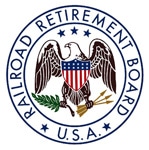
The chief actuary of the Railroad Retirement Board (RRB) said in his triennial report that the railroad retirement fund will remain solvent with no cash flow problems for nearly three decades, barring any unforeseen drops in rail worker employment over that time.
The positive forecast led the reviewers to conclude that the RRB payroll tax structure should remain unchanged at present, yet they also warned that future job losses could jeopardize the system in years to come.
“The long-term stability of the system, however, is not assured,” Chief Actuary Frank J. Buzzi and his staff wrote. “Under the current financing structure, actual levels of railroad employment and investment return over the coming years will determine whether additional corrective action is necessary.”
Chief Actuary Frank Buzzi and his staff said in the report, submitted by RRB in mid-June to President Donald Trump, Vice President Michael Pence and Speaker of the House Paul Ryan, that cash flow for rail retirement appears stable until 2047.
“The conclusion is that, barring a sudden, unanticipated, large drop in railroad employment of substantial investment losses, the railroad retirement system will experience no cash flow problems during the next 29 years.” Frank Buzzi and his staff wrote.
The review assumed three scenarios for passenger and freight railroad employment from 2017 and the years after and projected the status of the system out to 2091.
- Scenario 1 (optimistic): Average railroad employment starts at 223,000, with passenger employment steady at 48,000 workers and a constant annual decline in freight rail employment of 0.5 percent for 25 years at a reducing rate over the next 25 years and then remaining level thereafter.
- Scenario 2 (moderate): Average railroad employment starts at 223,000, with passenger employment steady at 48,000 with a constant annual decline in freight rail employment of 2 percent for 25 years, at a reducing rate over the next 25 years, and remain level thereafter.
- Scenario 3 (pessimistic): Average railroad employment starts at 223,000, with a decline of 500 workers per year in passenger employment until it stabilizes at 40,000; freight employment would decline at a constant annual rate of 3.5 percent for 25 years, then at a reducing rate over the next 25 years, and remain level thereafter.
Only in the third scenario, with the loss of 122,000 workers over the 29 years, did the railroad retirement system run into cash troubles in 2047.
Held constant in the review were variables such as earnings (3.6 percent), cost-of-living increases (2.6 percent) and investment returns (7 percent). Also kept constant were non-economic factors such as mortality, disability, retirements and withdrawal.
Follow this link to read a PDF of the complete report.
Related News
- SMART-TD maintains support of current NS leadership
- Online fundraiser established for Local 821 officer’s family
- Ground broken on Brightline West — new rail jobs incoming!
- After FRA rule, Jared Cassity explains why we still need the Rail Safety Act
- ALERT for L.A.-area members — operator stabbing suspect at large
- SMART-TD wins SEPTA members’ security in their chosen craft
- Shining brightly in the midst of darkness
- Early-bird pricing for TD National Training Seminar ends April 30
- SMART-TD endorses U.S. Sen. Mike Braun (R-Indiana) as the next governor of the Hoosier State!
- FTA action on bus, transit safety plans praised by SMART-TD